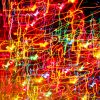Smart Lighting – using data to address the unexpected

Smart lighting systems have the potential to close the gap between lighting control and building data analytics. Data captured by lighting systems – such as space occupancy – that was previously used only to control the lighting itself, can now be made available for additional services. The agility of wireless smart lighting systems removes previous restrictions for re-configuration and re-purposing to address new, unexpected, and therefore unplanned use cases.
The recent COVID-19 pandemic is such use case. It surely was unexpected and few – if any – new buildings had been built with such situation in mind. It provides an illustration of the importance of designing systems such as lighting controls not as fixed function, fixed purpose designs but rather as flexible and agile systems that can be quickly adapted to meet expected and unexpected requirements. This provided an opportunity to reflect on the role that wireless smart lighting systems can play – and in fact do play – to address the challenges of today and tomorrow.
Evolution of lighting control
If we think back to the early days of lighting control, there were only wired solutions. Switches, dimmers and sensors were placed at fixed locations and wired to the lights. Any change in the layout – such as re-partitioning an office area – required re-wiring. Wireless solutions addressed this restriction, providing more flexibility and convenience. Removing the fixed, inflexible connection between sensors and lights greatly simplifies the re-use of the available sensor data by other applications for analysis, visualization and optimization.
Key drivers for investments in new lighting systems are cost pressure – both by energy and labor cost – and regulatory standards such as Title 24 demanding energy optimizations. Wireless lighting control systems providing functionality such as automatic lighting switch-off in unused rooms, light level control depending on available daylight and user-controlled light settings can be installed with minimal re-wiring and meet these important requirements.
Providing data via lighting control systems
Data is the foundation for smartness. It is not possible to make smart decisions without the required data and this is true for smart buildings as well. Fortunately, a lot of the required data is already available in lighting systems and just requires a network that captures and transports the data from the sensors using open standards like Bluetooth, Zigbee or EnOcean and provides them to other applications via open, standardized interfaces. Access to usable data is the pre-condition for triggering meaningful actions via a user interface or by integration into the building automation system.
Leveraging Smart Lighting systems
Let’s come back to the pandemic. COVID-19 has provided a new context to previously existing use cases:
| CLASSIC USE CASE | NEW USE CASE | |
|---|---|---|
| Utilization monitoring | Enforce capacity restrictions | |
| Cleaning on demand | changed to | Ensure hygiene requirements |
| Automated control | Provide touchless control | |
| Asset tracking | Enable contact tracing |
Smart lighting systems should have been in a good position to address the suddenly arising challenges since occupancy is monitored in practically all modern lighting control systems.
Reality check
The adaption of most smart lighting systems to COVID-19 was challenging. Practical issues prevented data re-purposing in many installations. Access was suddenly very difficult; installation effort and time became gating factors. Therefore, remote administration was essential. Data-driven lighting systems were clearly on the winners’ side since the adaption effort was low.
Adding new functionality was only possible if interoperable devices providing the required functionality existed. Open ecosystems were at an advantage as they provided access to a wide range of compatible devices rather than locking in users to a proprietary solution with a fixed set of functions. Being able to add new functionality such as people counting, desk and room level monitoring was quickly possible. Integration into customer applications allowed capacity planning, cleaning scheduling and the enforcement of capacity restrictions. Controlling ventilation based on space utilization based on the sudden, new requirements was possible only for solutions that could integrate with the building control system.
Key learning for a flexible future
I think one of the most important learnings is that we simply can’t anticipate all future use cases at design time. As we have seen, control systems must evolve from single purpose silos to generic, interoperable, data-driven systems and their design has to be flexible and extensible.
Smart spaces are not possible without the required data. Data is money and data that is captured but not accessible is therefore wasted money. The design of sensor and control systems in buildings must account for that.
Lighting systems have a central position in buildings; they offer a high density of nodes and often integrate powerful sensor functionality which uniquely enables them to be a data backbone. Using lighting systems to capture, transport and export sensor data is therefore a great opportunity to monetize the investment and to enable smart spaces.




